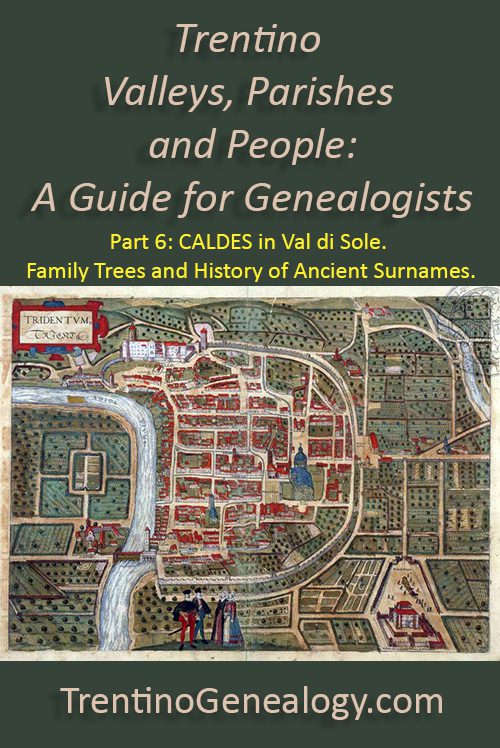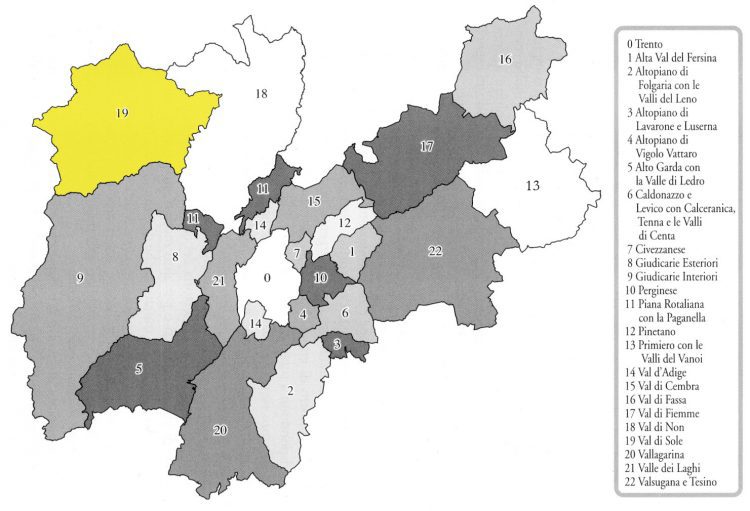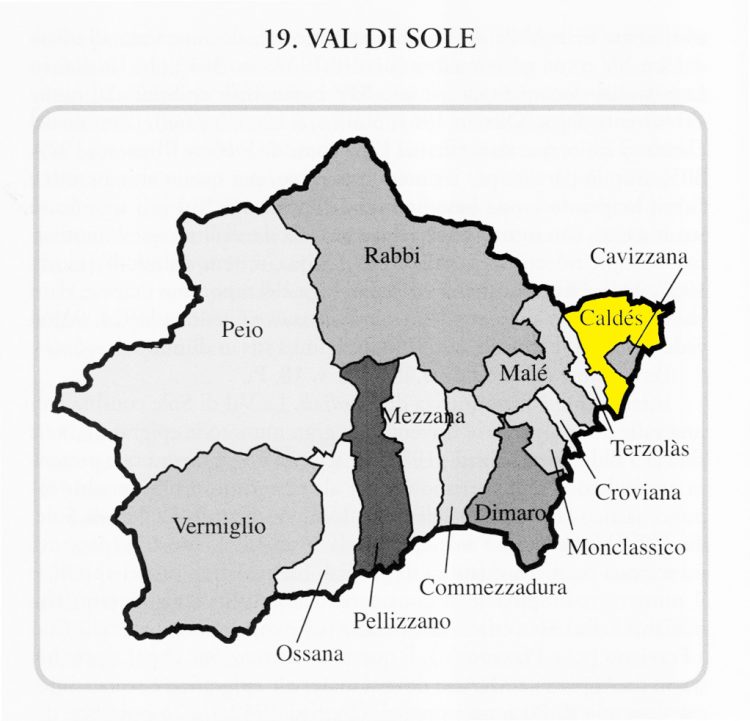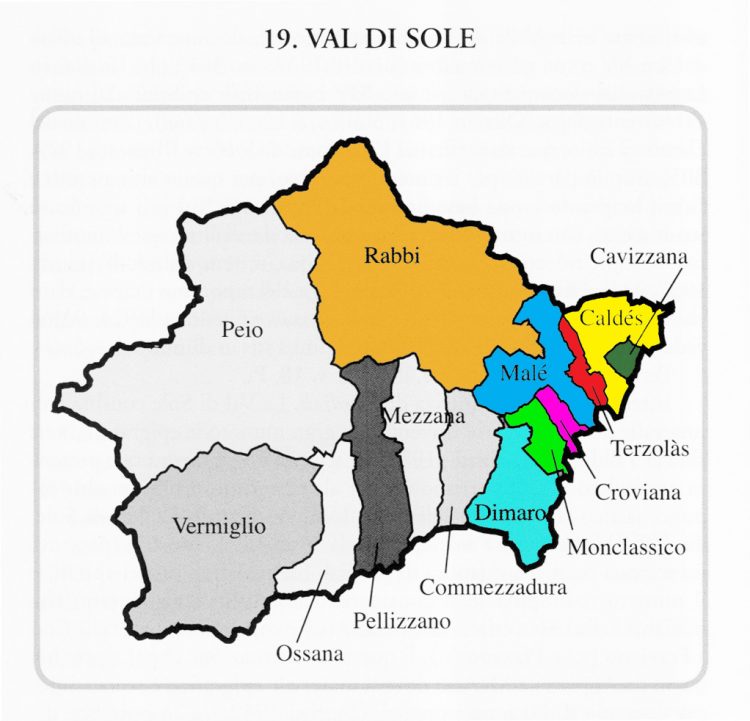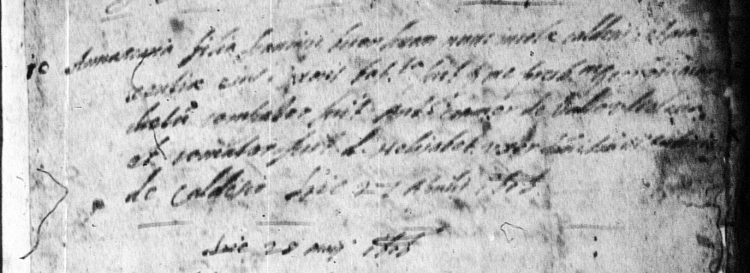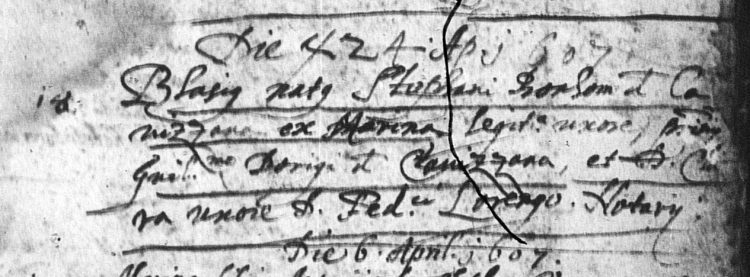A Treasure Trove of Family Trees of the Ancient Families of Caldes. Part 6 of ‘Trentino Valleys, Parishes & People: Guide for Genealogists’ by Lynn Serafinn.
These past few weeks I was working on a tree for a client whose ancestry in the 1600s took me on a journey through the historic parish of Caldes in Val di Sole. I found this research so interesting, I decided to feature Caldes as the topic for my last ‘Filò Friday’ podcast (5 February 2021). I also decided, while it was fresh in my mind, to make Caldes the feature of the next part in my blog article series on ‘Trentino Valley, Parishes and People’.
WHAT WE’LL EXPLORE TODAY
Called ‘a noble community’ by author and historian Alberto Mosca, many of the families of Caldes are well documented back to the medieval era. But Caldes also has a true ‘genealogical treasure’ in its parish registry: a collection of family trees of the ancient families of Caldes made by Father Tommaso Bottea in the 19th century.
In this article, I will discuss:
- Where Caldes is in the province, and its connection with other nearby parishes.
- The state of the surviving parish records for Caldes.
- Who Father Tommaso Bottea was.
- Details of the Caldes family trees made by Father Bottea: what families they cover, what the trees contain (and what they don’t), how they are organised, and how to use them in your research.
- Surnames and history of the ancient families of Caldes, including their linguistic and geographical origins, as well as the titles of nobility conferred on some of these families.
So, while some of you might have been expecting another article on Val di Non, I hope you enjoy our excursion today to Val di Sole. Even if you don’t think you have ancestors from Caldes, I am sure you will find this to be a fascinating journey into our Trentino culture and history.
VIDEO PODCAST
If you wish, you can also watch the Filò Friday podcast on Caldes below:
SIDE NOTE: Apologies to those looking for Filò Friday podcasts from Oct 2020 through Jan 2021. I just haven’t had time to edit them for YouTube yet! You can see them ‘on demand’ (but unedited) in our Facebook group at https://www.facebook.com/groups/TrentinoGenealogy, in ‘Guide 1: Video Podcasts’.
CALDES: Where It Is in the Province
To get oriented, here is a map I shared with you back in the first article in this series, showing the various valleys of Trentino. I have highlighted Val di Sole (number 19) in YELLOW. Notice how Val di Non (number 18) lies on its eastern border, and Giudicarie Interiore (number 9) – but more specifically Val Rendena which is included in the Giudicarie on this map – runs along its southern border.
click on image to see it larger
Now, if we zoom into Val di Sole, we see Caldes (highlighted in yellow) sitting right on the eastern tip of the valley, just on the border of Val di Non:
click on image to see it larger
These maps were taken from the book Toponomastica Trentina: I Nomi delle Località Abitate by Giulia Mastrelli Anzilotti (2003).
The Frazioni of Caldes
One of the limitations with the maps from Anzilotti’s book is that they show the civil comuni (municipalities), which frequently change. Also, they don’t show all the frazioni (villages/hamlets) contained within each comune, although she discusses them in detail in her book.
Within the comune of Caldes are seven frazioni:
- Bordiana
- Bozzana
- Cassana
- Molini (i.e. the mills)
- Samoclevo
- San Giacomo
- Tozzaga
Anzilotti tells us that all of these frazioni, with the exception of Samoclevo, are collectively known as ‘le Cappelle’, which was a term used in Val di Sole to refer to inhabited areas that were part of the community that had ‘non-curate’ churches (at least in the past).
The Decanato of Malé and its Curate Parishes
As a reminder, back when I started this series, I explained how Catholic parishes are organised in a hierarchical fashion: In English, this hierarchy is:
Diocese (or Archdiocese) –> Deanery –> Parish –> Curate
Or, in Italian:
Diocesi (Arcidiocesi) –> Decanato –> Parrocchia (Pieve) –> Curazia
All the parishes I discuss in this series are in the Archdiocese of Trento.
Caldes is a curate parish of the decanato of Malé, which includes the curate parishes of: S. Bernardo (Rabbi), Caldes, Dimaro, Monclassico, Bolentina, Piazzola, Terzolas, Samoclevo, Cavizzana, Magras and Pracorno. I’ve highlighted these on the map below, but remember the map shows comuni, not parishes, and some of the parishes are contained within these comuni:
click on image to see it larger
The Parish Registers for Caldes
Below is a summary of the surviving parish registers for Caldes, with some observations I have made in my own research. I include the number of the LDS microfilms, as this is the medium most familiar to many of you. However, the LDS Family History Centres have stopped making their microfilms available to the public, as they gradually transfer their libraries into digital format. After they are digitised, you will only be able to view them at a local Family History Centre, not online. ALL of these records were digitised by the Diocese of Trento more than a decade ago, and they are viewable at their archives in the city of Trento (again, not online).
SIDE NOTE: I feel most fortunate to have collected tens of thousands of Trentino parish records over the years, which has enabled me to work from home on many (but not all) projects. This has proved especially valuable for me and my clients during the recent COVID lockdowns and travel restrictions.
| PARISH REGISTER | LDS MICROFILM NO. | MICROFILM ITEM | CONTENTS |
|---|---|---|---|
| Baptismal INDEX | 1388646 | Part 31 | Contains index (page numbers) of volume 1 of baptisms for surnames A-F; L, M. These pertain to records that appear on the NEXT microfilm (1388647). There are no Caldes records on this film. |
| Baptisms vol 1-5 | 1388647 | Parts 1-5 | Baptisms: 1605-1702; 1703-1784; 1784-1817; 1818-1862; 1863-1922 |
| Marriages vol 1-3 | 1388647 | Parts 6-8 | Marriages: 1618-1815; 1820-1919; 1874-1923 |
| Deaths vol 1-3 | 1388647 | Parts 9-11 | Deaths: 1629-1818; 1816-1865; 1866-1923 |
| BOTTEA TREES | 1388647 | Part 3 | These appear at the very END of volume 3 of the baptismal register (part 3 of microfilm) |
NOTES AND OBSERVATIONS:
- All of the volumes are indexed, with page numbers. I have no idea why there are a handful of pages from the first baptismal index on a separate microfilm (1388646).
- GAP in Caldes baptismal records: 1663-1672; there is a note in the book that says where to look for them, but I haven’t found this in any of the photographed volumes.
- GAPS in marriage records: June 1659-Feb 1663; March 1700-Dec 1705; Dec 1738-April 1743. The dates of the marriage records leap around a lot, especially around the beginning of the 1800s.
- GAPS in the death records: Dec 1658-Jan 1663. There may be more, but I haven’t worked as much with the death records as with baptisms and marriages.
RESEARCH TIPS:
- CHECK MALÉ. Knowing that Caldes is part of the deanery of Malé is crucial because early records for Caldes (if they have survived) will most likely be found in Malé. The Malé baptismal records are particularly of importance, as they go back to 1554.
- CHECK ADJACENT PARISHES, ESPECIALLY FOR MARRIAGE RECORDS. Being familiar with the adjacent parishes is also important, as you might find relevant records for Caldes ancestors there, such as marriage records between a man from Caldes and a woman from a nearby parish.
- CHECK THE BOTTEA TREES. The Bottea trees (which I will discuss shortly) can be found at the very end of volume 3 of the baptismal register. They contain a wealth of information.
The Curious Case of Samoclevo
Before I move on to the Bottea trees, I’d briefly like to mention Samoclevo, as it can sometimes be a challenging parish to research. As we see above, Samoclevo is a frazione of Caldes, and a curate parish of Malé. While Samoclevo started keeping its own baptismal records in 1733, its marriage records don’t start until towards the end of that century (1771) and its death records start even later (1818).
As a rule of thumb, if you cannot find a record for Samoclevo, or you are looking for a record before these dates, your first resource should be the records for Caldes. If you cannot find it there, look in Malé. There’s actually no ‘straight line’ of logic for where you will find the record, as they often seem to jump around. There are also several small gaps in the Samoclevo records (possibly because of this administrative ambiguity).
Article continues below…
About Father Tommaso Bottea
One of the most wonderful treasures contained in the Caldes parish registers are the family trees of the ancient families of Caldes researched, constructed, and beautifully ILLUSTRATED BY priest, author, historian (and apparently an artist) Rev. Tommaso Vigilio Bottea of Monclassico.
Tommaso Bottea was born in Monclassico on 30 December 1819, and died in Malé on 13 February 1895, where he had served as parroco, as well as the deacon of the deanery of Malé (see above for a list of parishes this included). During the course of his life, he wrote many books, including a history of Val di Sole published in 1890.
But he also left behind two invaluable treasures for genealogists and family historians who are researching the families of Val di Sole: family trees of the historic families of Caldes and Malé.
We’ll look at the Malé trees in a future article, but today we’ll look at the trees he made for Caldes.
Families Included in Father Bottea’s Caldes Trees
In alphabetical order, the families included in Father Bottea’s Caldes trees are:
- Antonietti
- Bonomi
- Cova
- Fattarsi
- Lorenzo
- Malanotti
- Manfroni
- Rizzi
- Rosani
- Scaramella
Note, these are ONLY the Caldes lines of these families, as some also exist in other parishes.
There are also trees for the Guarnieri and Leita families (as well as an extension of the Rizzi family), but these were made by someone in the 20th century (not signed) and they don’t go back as far.
Content of the Bottea Family Trees
When working with the Bottea trees, it is crucial to understand what they contain – and what they don’t!
Father Bottea drew his information from the records from both Caldes AND Malé. Remember, as he was the head of the decanato, he would have had easy access to all of these registers.
As he made these trees as genealogical studies of the surnames, the trees contain only the MALE lines, i.e., sons of sons with that surname. Moreover, they do not include sons who died young or who had no children. The only exceptions are PRIESTS, and the rare instances of men whose names happened to appear in older documents that pre-date the registers.
The SINGLE exception of a daughter is in the Antonietti tree, where a daughter was the last heir of the family name, and whose husband adopted the surname after it died out via the male lines (more on this later in this article).
He did NOT make trees of families who were recent migrants to the parish, or who died out shortly after the records began (such as the Dalle Caneve, whom we will examine shortly).
Several of the trees contain elaborate illustrations of the stemmi (coats-of-arms) of those families who were nobility, with details about when, to whom and by whom these titles were granted. These beautiful drawings (and the information they contain) make these trees especially wonderful to study.
Be aware that some of the pre-registry information Bottea gives has been gleaned via other kinds of documentation, such as ‘pergamene’ (parchments) of legal documents, etc., which are in the archives for those parishes or comuni.
Organisation of the Bottea Family Trees
When working with the Bottea trees, it is also important to know which information is included, and how he chose to organise it.
He did not put any birth dates in his trees; rather, he recorded the MARRIAGE DATE of each couple, or an estimated YEAR of marriage in cases where it would have occurred before the beginning of the records.
When he knew the surname of the wife, he included it in the tree; if not, then only her first name will be in the tree.
In the case of early marriages where the children were born before the beginning of the surviving registers, you will see only the patriarch’s name, with no wife.
In some cases, he recorded a person’s DEATH DATE (or year of death). You will recognise these by a cross (+) before the date/year.
If a man served in the military, he often includes those details, especially if he was an officer and/or someone who died in battle.
If a branch of the family migrated to another parish and/or outside the province, he also recorded what he knew about them.
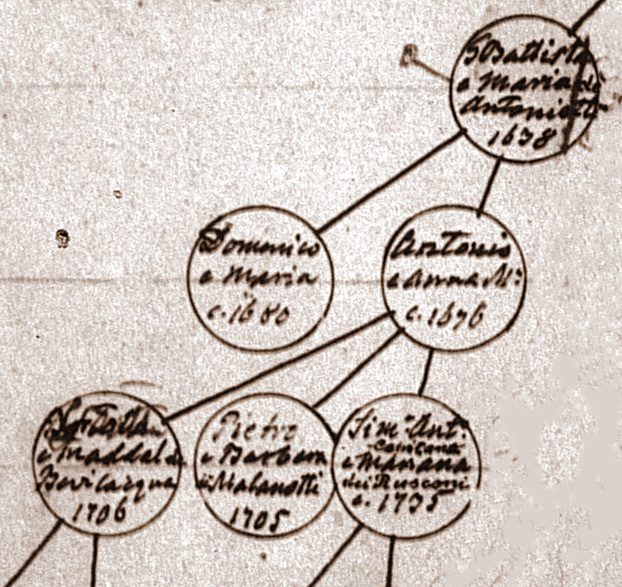
Above: close-up of part of the Manfroni tree by Father Bottea. Notice how the first two marriages in the bottom row and the marriage in the top row have surnames of the wives, as well as a specific year of marriage. This tells us he located the marriage records in the register for either Caldes or Malé. In the lower right, we have a surname of the wife, but only an estimated marriage year, while in the middle row, we have only the first name of the wives, and an estimated marriage year. This means these marriages took place outside Caldes or Malé, and Bottea had not been able to identify them.
A few caveats:
- A few dates have been scribbled over. As I have not seen the original books (and digital images are all in greyscale, so I cannot tell if there are different colour inks), I cannot say which (if any) of these corrections were most likely made by don Bottea himself or by some else, after the fact. This can sometimes result in ambiguity in some of the trees.
- At least one tree (Manfroni) contains some speculation about early medieval origins (circa 1200), resulting in information that seems to leap over several generations.
How to Use the Bottea Trees in Your Research
If you have these surnames in your family tree, and you’ve been able to identify your nearest male ancestor with the surname in one of the Bottea trees, that’s great. Now, you can use the Bottea tree as a starting point for that surname, and try to find the marriage, birth and possibly death records to support what Bottea has outlined.
But let’s say the first ancestor with that surname you’ve discovered is not male, but female. Well, obviously, you’re not going to see her name on the tree itself, as he only recorded male lines. But you can still use these trees to identify her ancestry by working through the following steps:
- FIND OUT HER FATHER’S NAME. The first task would be to find out her father’s name; this is first done via her marriage record. As already mentioned, the marriage records for Caldes go back to 1618 (although there are occasional gaps). Hopefully, you’ve found that record, and you know at least her father’s name (it is rare for marriage records before the 1800s to have a mother’s name). If you cannot find a marriage record, you can estimate the date by finding all the children for that couple, and then estimating the marriage about one year before the birth of the first child.
- CREATE AN ESTIMATE FOR DATE OF BIRTH. Once you found a marriage date (or created a marriage estimate) you can estimate the date of birth for that woman either by the date of marriage, or by the date of the youngest known child. Before the 20th century, Trentino women tended to marry between the age of 19 and 22, although you will occasionally see them marry younger or older. Of course, if she (or her husband is widowed), she is likely to be older at the time of marriage. Typically, a healthy woman would continue to have children until she was about 42-44 years old, so finding as many children as you can for her will really help you zero in on a good estimate for her date of birth.
- LOCATE BIRTH RECORD (if it exists). Once you know her father’s name and you’ve created a good birth estimate, the next thing to do would be to find her actual birth record, if she was born within the range of the surviving baptismal records for Caldes (1605 and after).
- FIND HER SIBLINGS’ BAPTISMAL RECORDS. Spending some time finding the baptismal records of all the siblings of your female ancestor can help you estimate the marriage date of her parents, and thus identify which of the possible couples on the Bottea tree are YOUR ancestors (especially in the case when there is more than one man with the same name). They also may contain information your ancestor’s baptismal record does not have.
- LOCATE YOUR ANCESTORS ON BOTTEA’S TREE. Once you’ve gone through all those steps, you should be able to find your ancestors on Bottea’s tree for that surname. From that point, it’s just a matter of plugging in the information he has on his tree, and then looking for the documents to support his dates.
IMPORTANT: If you haven’t personally located the documents for a marriage, birth or death, but are simply inserting Bottea’s information into your tree, be sure to cite HIM as your ‘source’ of information. This way, you can go back to the tree and look it up, and try to follow it up another day. Never, ever enter information without saying WHERE you got it.
Article continues below…
Histories of Eight Ancient Families of Caldes
As promised, I’d now like to share a few short histories of some of the most ancient families of Caldes. All of these families – with the exception of Dalle Caneve – are represented in Father Bottea’s family trees in the Caldes registry.
Dalle Caneve
Originally seen in records as ‘Canipis’ or ‘Canepis’, the Dalle Caneve appear in documents back to the 1300s. Historian Alberto Mosca tells us that the first citing of the name is from 1386, when a Bartolomeo is indicated as a settler in Val di Rabbi. Mosca also tells us that this family were in the service of the Counts of Flavon, and that in that capacity, they start to be seen present in Caldes on feudal properties of their Lords by the end of the 1400s. He also says a Bartolomeo and Bonomo Dalle Caneve participated in the Guerra Rustica (‘Rustic War’) of 1525. Later, in 1559, a ‘Peter da le Caneve’ of Caldes is cited as being in the service of the Counts of Thun.
In my own research, I first stumbled upon this surname in Caldes with the 1635 marriage record of Matteo Malanotti (son of Giovanni) and Margherita Dalle Caneve. Although the record says she is the daughter of Marino/Martino, I suspect this is an error, and that she was actually the daughter of Michele (as per a baptismal record dated 8 Feb 1616).
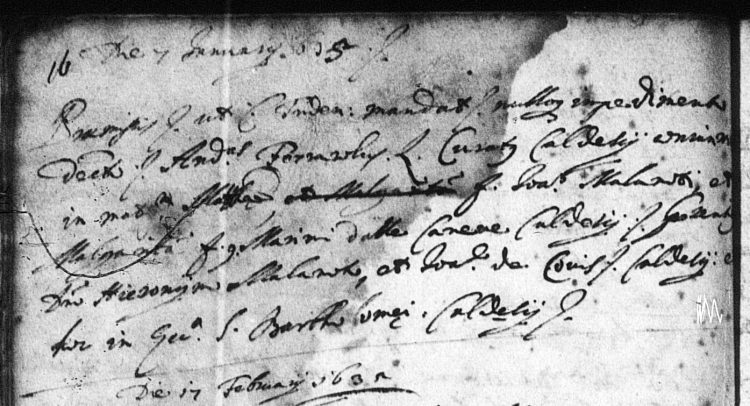
click on image to see it larger
There are a handful of Dalle Caneve baptisms in Caldes in the early years of the 1600s, after which they appear to have ‘daughtered out’ and gone extinct before the middle of the century. A branch of the family who transferred to Val di Rabbi, however, survived there until the end of the 1800s.
Father Bottea didn’t create a tree for the Dalle Caneve, most likely because they had been extinct in Caldes for at least 250 years by the time he did his research. However, they are an important family to remember because, according to historian Alberto Mosca, they may have an ancestral connection to at least two of the other historic families of Caldes: the Bonomi and the Manfroni.
Bonomi
Bonomi is a patronymic from the man’s name ‘Bonomo’, from the Latin ‘bon + homo’, meaning ‘good man’ or ‘good human being’.
Alberto Mosca tells us that the name ‘Bonomo’ was a recurring name in the Dalle Caneve family through the end of the 1500s, which he feels adds weight to the hypothesis of an ancient ancestral connection between the Bonomi and the Dalle Caneve.
Mosca also reports that the first known diploma of nobility for the family was for a ‘Pietro Bonhomo’, who was ennobled in 1370 by Emperor Carlo IV (as per an epigraph from the 1600s).
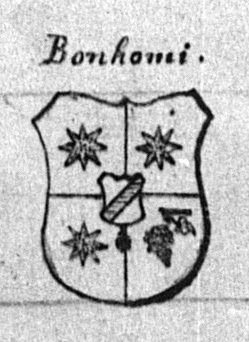
We know from surviving records that the Caldes Bonomi originated in nearby Cavizzana. For example, the earliest surviving baptismal record for a Bonomi in Caldes is for an Anna Maria, daughter of Francesco Bonomi and Massenza (Manfroni), dated 27 April 1606:
click on image to see it larger
Admittedly difficult to read, her father is referred to here as ‘Francesco Buon Homo, now living (nunc incola) in Caldes’, implying that is not where he was originally from.
In this baptismal record from the following year, we find a ‘Blasio (Biagio), son of Stefano Bonhom’ and Marina, born 4 April 1607. Here the priest specifies that Stefano came from Cavizzana:
click on image to see it larger
Thus, it would appear that the Bonomi arrived in Caldes sometime toward the end of the 1500s, and that they are an extension of the original Cavizzana family. Bottea identifies the patriarch of this line as a man named Bonomo (son of Martino, of Cavizzana), who was most likely born in the mid-1400s. Thus, all Caldes Bonomi are ancestrally related to the Cavizzana Bonomi.
The family’s diploma of nobility, as sculpted on the historic Bonomi house in Caldes, was later confirmed by the Emperor Ferdinando III (reigned 1637-1657) to the Caldes notary, Aurelio Bonomi. Aurelio, who was the son of the same Francesco Bonomi and Maria Malanotti in the above record, married a Lucia Manfroni around the year 1616. These are all noble families of Caldes. Mosca says there are two doors (dated 1608 and 1638) on the present-day street ‘via Manfroni Prati’ in Caldes that depict the Bonomi stemma.
While this surname appears in many other parts of the province, it would be wrong to assume they are all related. You will find it in various parts of the Giudicarie, Arco and especially in Pinzolo in Val Rendena. Tabarelli de Fatis mentions a noble Bonomi family from Pinzolo, who were living in Trento. An Antonio from this family was granted a stemma by Prince-Bishop Carlo Gaudenzio Madruzzo on 25 July 1615.
Manfroni
Manfroni is a patronymic surname, derived from a patriarch named ‘Manfrone’ (or ‘Manfrono’) of Caldes, whose name appears in a record dated 1480. In that document, he is said to be the son of the late Pietro, and grandson of the late Girardino. As with the Bonomi, Alberto Mosca believes the Manfroni were originally a branch of the now extinct the Dalle Caneve family. Like the Dalle Caneve, he has found evidence they were in the service of the Counts of Flavon.
Alberto Mosca tells us that the Manfroni are documented well into the 1400s, and that they are the only family among the ancient nobility of Caldes who are still in existence.
By the 1600s, there were at least six branches of the Manfroni family present in Caldes, all of which are represented in the Manfroni tree by Father Bottea.
Another noble family of Caldes, the first known title and stemma of nobility for them was awarded on 25 April 1554 to captain Giovanni Giacomo Manfroni (captain of the cavalry) of Caldes and his brothers Bernardino and Baldassare ‘and their legitimate descendants’ by Ferdinand I, Holy Roman Emperor.
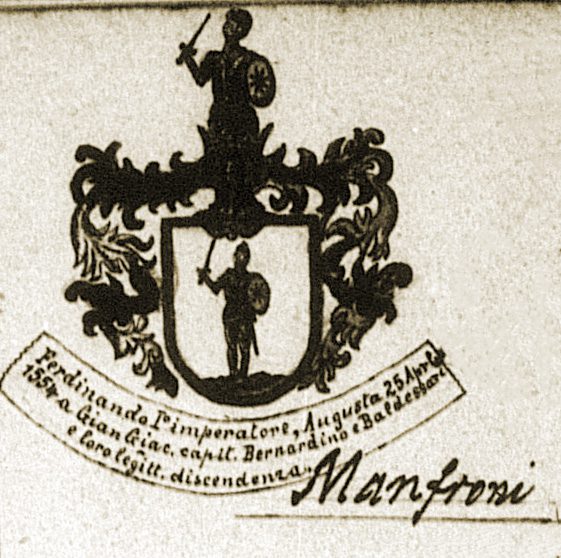
On 23 May 1726, H.R. Emperor Carlo VI awarded the predicate ‘de Manfort’ (also see Monfort and Montfort), and the rank of Knights (cavalieri) of the Holy Roman Empire to the relatives of Bernardino, Giovanni Giacomo, Giovanni Federico and Giovanni Antonio. On 28 Oct 1766, Antonio Manfroni of Caldes was granted an embellishment of his coat-of-arms by Holy Roman Emperor Ferdinando I.
During his short but tyrannical reign in Trentino at the end of the 1700s, Napoleon managed to dissolve both the Holy Roman Empire and the office of the Prince-Bishop of Trento, as well as nullify all noble titles. However, after he was ousted, and the Austrian empire took his place (which later became the Austro-Hungarian empire), some of the higher-ranking noble families managed to regain their titles and noble privileges.
One of these families was the Manfroni of Caldes. Not only did they regain their noble privilege, they were elevated to the rank of Knights of the Austrian Empire by Francesco Giuseppe on 30 March 1855. Later, Maurizio Manfroni, ship captain, was elevated to the rank of BARON of the Austrian Empire on 23 Jan 1874, and they were added to the list of ‘noble Tirolese’ in 1886.
Antonietti
This family’s surname was originally ‘Dalla Piazza’, also seen ‘de Platea’ or ‘De Plateis’ in Latin sources.
In his Caldes trees, don Bottea shows us a Domenico dalla Piazza, born sometime before 1500, and his son Antonio who appears in records around 1524. This Antonio had the nickname ‘Toniet’. This Antonio ‘Toniet’ had a son named Domenico, and it is from his descendants, that the surname Antonietti starts to appear around the year 1600.
Although it seems the family were already ennobled in some way before the year 1500, this Domenico, who was probably born around 1570, was elevated to the rank of ‘Conte Palatino’ (Palatine Count) in 1645. This title was originally associated with one of the most illustrious positions of the early Middle Ages in the kingdoms of the Franks, but it gradually lost importance over the centuries. They were also granted various titles from the Prince-Bishops in the 1700s.
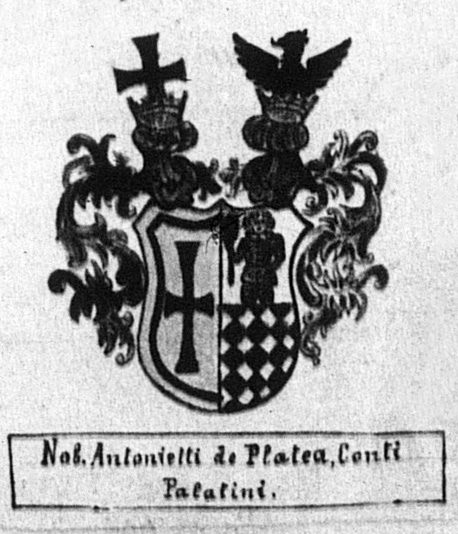
A branch of the family, headed by Giovanni Battista Antonietti, settled in Malé around 1655.
Both the Caldes and Malé lines are now extinct. If you look on Nati in Trentino, there are no Antonietti (sometimes entered ‘de Antonietti’) born in Caldes after 1825, and none at all in Malé. Apparently around the middle of the 1700s, a Chiara Antonietti married a Cristoforo Caretta, and because there were no male heirs to the noble title in that line, their son Michele Caretta (who married a Francesca Manfroni in 1777) was granted the right to append the name Antonietti to the surname Caretta, resulting in the new surname ‘Caretta-Antonietti’.
There are a few Antonietti in the city of Trento and in Ledro in the early 20th century, but I currently have no idea where these lines originated.
Malanotti
‘Malanotti’ is a conjunction of the word ‘mala’ for ‘bad’ and ‘notte’ or ‘nocte’ for ‘night’. Thus, it means somebody in the past had a ‘bad night’. Alberto Mosca says the surname is found in numerous Italian places in the medieval era, as well as in the parish of Ossana in 1281.
In the specific case of Caldes, this surname came from a soprannome given sometime in the 1400s to someone whose original surname was ‘Arpolini’. The surname ‘Arpolini’ or ‘de Arpolini’ is a patronymic, derived from the man’s name Arpolino. Alberto Mosca says the name Arpolino (which was recurring name in the noble families of Flavon and Caldes) is probably a variant of a German name, such as Arpo, or Aribo, so, perhaps this family has some Germanic roots.
The family appear to have already been ennobled by the late 1300s, as per the decima (record of tithes) of Terzolas in 1385, where we find cited a Nicolò, son of the late ‘Sir’ Arpolino of Caldes.
While Father Bottea’s tree traces the ‘de Arpolini’ back to the late 1300s, the name ‘Malanotti’ starts to appear as a soprannome – a personal nickname – sometime in the mid-1400s with an Antonio, who was the son of the Nicolò I just mentioned.
The oldest known stemma for the family is in the ceiling of the church of San Rocco in Caldes, painted in 1512, for a ‘Sir’ Bernardino Arpolino, ‘vulgo Malanot’. Apparently, this church was built by Bernardino and other benefactors in thanks for surviving an outbreak of the plague in 1510 (San Rocco is the patron saint for plague victims).
Bernardino Malanotti’s stemma appears above the altar in the church, at the far right. To its left is the stemma of the Emperor Massimiliano, followed by the stemma of Prince-Bishop of Trento Giorgio Neideck. At the far left is an allegorical depiction of Death personified.
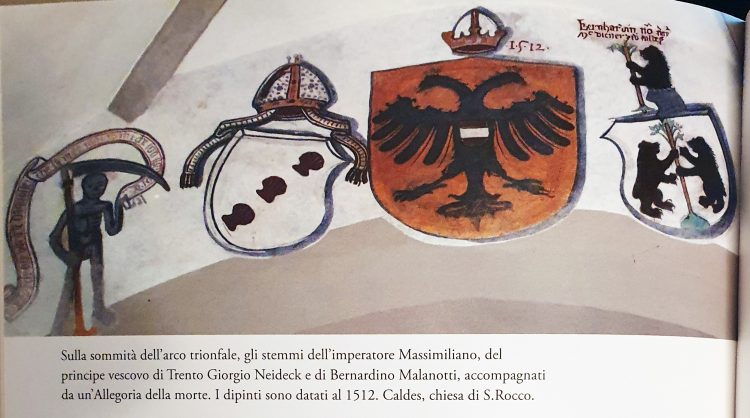
The stemma depicts two bears grabbing either side of a tree. I’m not sure if the bear on top is still part of the stemma, or just an illustration of the story behind the stemma. Alberto Mosca calls this a ‘talking’ coat of arms, showing us the kind of ‘bad night’ the family member spent: a certain member of the family sheltered in a tree. Although he doesn’t delve any deeper, my friend, client, and colleague, Gene Pancheri, shared a local legend about the origin of this nickname. The story goes that, after having been chased by a brown bear, a man took refuge at the top of a tree, because he knew brown bears cannot climb trees. However, the bear was persistent, and would not leave, causing the man to spend the entire night up in the tree before the bear finally gave up and moved on. From this point on, this man was nicknamed ‘malanot’ or ‘malanotti’, i.e., the man who once had an infamously ‘bad night’.
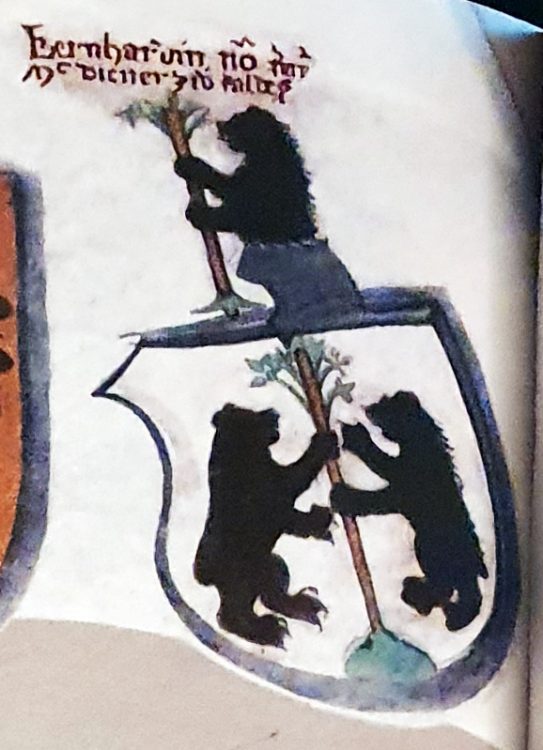
Who was this original ‘Malanotti’ who spent his night up a tree? The evidence suggests it was probably Antonio Arpolino, sometime in the mid-1400s.
Mosca gives a wealth of additional information about illustrious Malanotti throughout the centuries. While I don’t have room to mention them all, one that stands out is another Bernardino Malanotti, most likely the grandson of Bernardino whose stemma appears in the little church of San Rocco. This Bernardino is documented in 1598 as being an imperial advisor, and secretary of the Archduchess Anna Cattarina in the Courts at Innsbruck and Vienna. Apparently, he also accompanied the then Princess Cecilia Renata (daughter of Holy Roman Emperor Ferdinand II, of the House of Habsburg) to Poland, where she would be crowned Queen of Poland.
At least two Malanotti lines emigrated from Caldes to Ceresé in Val di Rabbi in the 1500s, where the surname mutated to ‘Breton’ and Marinolli. Other lines were in Terzolas, where it went extinct in 1742.
Fattarsi
Fattarsi is a toponymic surname, i.e., a surname derived from the name of a place. It is of Germanic origin, and it took some time before it fully developed into the surname as it appears today.
According to Rev. Tommaso Bottea, the name ‘Fattarsi’ is a contraction of the words ‘Pfarre Tartsch’ (sometimes written Tarschg), meaning ‘(of) the parish of Tartsch’, which is in Val Venosta in South Tyrol (aka province of Bolzano). He estimates the surname was in use in Caldes by around 1590, although I see only very early (and not quite ‘fully baked’) versions of the surname during that era.
The founding father of the Fattarsi family of Caldes was a Federico Fattarsi, who arrived in Caldes from South Tyrol sometime by 1590, after marrying a woman named Brigida from Castelfondo. They had at least five children together. Thus, all of the present-day Fattarsi of Caldes are related, as they are descended from this same couple.
The 1594 baptismal record of their son Giovanni Giacomo refers to Federico as ‘Federico Fortag, a German living in Caldes’. In the baptismal record of their son Michele (4 Aug 1591), the priest refers to Federico as ‘Federico Fortach, teutonico chellero’ (Teutonic/German Keller), employed by the Most Distinguished dom. Filippo Thun of Castel Caldes’.

click on image to see it larger
A ‘Keller’ is the keeper of the wine cellar/cold food cellar. As there is no ‘K’ in the Italian vocabulary, it is often spelled ‘Cheller’. For this reason, some of the early baptismal records are recorded under the surname ‘Cheller/Keller’, and we also see ‘Cheller/Keller’ used as a soprannome for this family some subsequent generations. Don Bottea also mentions this occupation in his research.
The family produced many priests who worked in the curate churches in Caldes and Val di Rabbi, especially during the mid-1700s to early 1800s.
Rosani
Rosani is another patronymic, based on the man’s name ‘Rosano’ or ‘Rochesano’. Father Bottea says this family can be traced back to a ‘Rosano of Caldes’ who allegedly lived sometime in the 1200s. However, in working with the Bottea tree for Rosani, the dates don’t quite work, and they seem to leap over several generations in the very early years. Also, someone (I don’t know if it was Father Bottea or a later researcher) wrote the name ‘Rochesano’ over the name ‘Rosano’ in two places in the tree.
Alberto Mosca’s research might clear up some of the ambiguity of this ‘very ancient’ family. He tells us that a ‘Rochesano, son of the late Michele’ is cited in records dated 1393 and 1399, and another ‘Rochesano, son of the late Michele’ is found two generations later in 1465. This younger Rochesano is cited as being a ‘muln’, i.e., a miller (mugnaio), an occupation which seems to have continued for many generations (note I mentioned earlier there is an area in Caldes known as Molino, which means ‘mill’). We then find a ‘Michel Rosan of Caldes’ at the end of the 1400s and again in the early 1500s, where he is included in a list of people who were obligated to pay for public education to the Count Valentino Spaur.
In comparing these two sources of information, we can interpolate how these men fit into Father Bottea’s tree. Just from naming conventions, I would have presumed the youngest Michele mentioned was the son of Rochesano/Rosano, and Bottea’s tree does show this to be the case. However, from his tree, it seems Michele’s line died out, and the line that survived to carry on the surname was via a different son, named Antonio:

click on image to see it larger
Mosca tells us that a Bartolomeo Rosani of Caldes, son of Paolo, was living in Livo in 1541, and that some members of this branch emigrated to Brescia (in Lombardia) in the 1800s, where they set up an award-winning business as engravers.
Scaramella
This family were originally from Valtellina in the region of Lombardia. The patriarch of the Scaramella line was a Domenico who came to Caldes sometime before the beginning of 1600. He had at least two sons (most likely born in Lombardia) Antonio and Giovanni, but according to Father Bottea’s tree Antonio’s line appears to have died out by the end of the 1600s. Thus, all Scaramella of Caldes today are descended from Domenico’s son Giovanni and his wife Cattarina. Alberto Mosca tells us that the family were active in local commerce by the year 1633.
Regarding the linguistic origins of the name, Aldo Bertoluzza says it may be a variant of the word ‘scaramuccia’, which means a ‘skirmish’.
Although the surname is still present in Caldes today, only a handful of Scaramella families remain there. It is much more common in its region of origin, Lombardia, especially in the provinces of Sondrio and Brescia.
Closing Thoughts
For those of you with Caldes ancestors, I hope this article has been informative and useful. And to those of you who do not, I do hope you found it interesting. Speaking for myself, I am always fascinated by the histories of Trentino families.
As mentioned, there are several other ancient surnames of Caldes that were researched by Father Bottea, which I have not covered in this article. There are also many other Caldes families who arrived in the parish later, many of which are covered by Alberto Mosca in his book on Caldes, which you will find in the references below.
All of these surnames (including those I have not mentioned here) will be covered in my book in progress entitled Guide to Trentino Surnames for Genealogists and Family Historians. I hope you follow me on the journey as I research and write this book; it will probably be a few years before it comes out, and it is likely to end up being a multi-volume set.
If you enjoyed this article, and would like to receive future articles from Trentino Genealogy, be sure to subscribe to this blog using the form below.
Until next time!

Warm wishes,
Lynn Serafinn
8 February 2021
P.S. As you probably know, all my 2020 trips to Trento were cancelled due to COVID-19 lockdowns. I am still not sure when I will be able to go back in Trento, as we are still in lockdown here in the UK, and the government is still advising against making any travel plans. Fingers crossed, I will be able to go there by the summer, but there really is no way of knowing for sure at the moment.
However, I do have resources to do a fair bit of research for many clients from home, and I now have some openings for a few new client projects starting in April 2021.
If you would like to book a time to discuss having me do research for you, I invite you to read my ‘Genealogy Services’ page, and then drop me a line using the Contact form on this site. Then, we can set up a free 30-minute chat to discuss your project.
Join our Trentino Genealogy Group on Facebook: http://facebook.com/groups/TrentinoGenealogy
Lynn on Twitter: http://twitter.com/LynnSerafinn
View my Santa Croce del Bleggio Family Tree on Ancestry:
https://trentinogenealogy.com/my-tree/
REFERENCES AND RESOURCES
ANZILOTTI, Giulia Mastrelli. 2003. Toponomastica Trentina: I Nomi delle Località Abitate. Trento: Provincia Autonoma di Trento, Servizio Beni librari e archivistici.
BERTOLUZZA, Aldo. 1998. Guida ai Cognomi del Trentino. Trento: Società Iniziative Editoriali (S.R.L.).
CASETTI, Albino (dottore). 1951. Guida Storico – Archivistica del Trento. Trento: Tipografia Editrice Temi (S.R.L.).
MOSCA, Alberto. 2015. Caldes: Storia di Una Nobile Comunità. Pergine Valsugana (Trentino, Italy): Nitida Immagine Editrice.
STENICO, P. Remo. 1999. Notai Che Operarono Nel Trentino dall’Anno 845. Trento: Biblioteca San Bernardino. Can be downloaded for free in PDF format from http://www.db.ofmtn.pcn.net/ofmtn/files/biblioteca/Notai.pdf
STENICO, P. Remo. 2000. Sacerdoti della Diocesi di Trento dalla sua Esistenza Fino all’Anno 2000. Can be downloaded for free in PDF format from http://www.db.ofmtn.pcn.net/ofmtn/files/biblioteca/Preti-Indice-Preti.pdf
TABARELLI DE FATIS, Gianmaria; BORRELLI, Luciano. 2005. Stemmi e Notizie di Famiglie Trentine. Trento: Società di Studi Trentini di Scienze Storiche.

